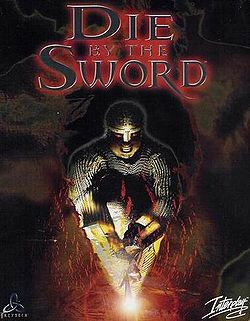- Die by the Sword
-
This article is about the computer game. For the phrase, see live by the sword, die by the sword.
Die by the Sword 
Developer(s) Treyarch Publisher(s) Tantrum Entertainment
Interplay EntertainmentPlatform(s) Microsoft Windows Release date(s) February 28, 1998 Genre(s) Action-adventure Mode(s) Single player adventure, single or multiplayer arena Media/distribution 1x CD-ROM System requirements Pentium processor, Windows 95, DirectX 5 compatible video card, 16 MB RAM
Die by the Sword is a computer swordfighting game developed by Treyarch, and published by Tantrum Entertainment (a sub-brand of Interplay Productions) on February 28, 1998. The title's main selling point was the introduction of the VSIM control system, which allowed players to independently command the movement and swordfighting of their ingame avatars; running, jumping, and turning with one hand, while simultaneously slashing, stabbing, and parrying with the other. While many games of this type allow for a similar dualism, Die by the Sword remains to this day unique in its treatment of physically correct and force based melee combat, as described below.
While the game was well received by critics, the PC releases of Eidos's popular—but only superficially similar—Tomb Raider franchise overshadowed and crippled Treyarch's sales figures. In large part this was due to what are widely viewed as very difficult controls, challenging gameplay, and a steep learning curve for novice players.
Die by the Sword also offered deathmatch and cooperative multiplayer play in its arena mode, where players could stage fights with up to three other players. The lack of a match-making service precludes any significant online community, which when combined with a poor online interface relegates the title to local games only.
The official expansion pack Limb from Limb, released December 31, 1998, added another main quest for single player enthusiasts, enhanced multiplayer through a selection of significantly more creative arenas, and introduced new playable characters such as the Minotaur.
Contents
Swordfighting
The unique feature of this game is also the most widely praised. This is the ability for the player to fully control their sword arm, removing the need for pre-recorded animations and statistically-based gameplay. Instead, a physically correct model is used for each avatar and each weapon, and both movement and damage are calculated through forces.
The sword arm can be controlled by using a joystick, the numeric keypad, or a mouse. For example, with the keyboard, to perform a slashing attack with the default key combination, a player would press the '4' and '6' keys on the numeric keypad in succession. This will move the weapon from extreme left to right. The '8'-'2' combination will likewise perform a top-down striking motion. Blocking is accomplished similarly, not through a separate key or state like in all other games of this genre, but instead through the simple physical principle of positioning the weapon so that it intercepts, and blocks, the enemy's weapon. Shields operate like swords in this respect, though it is generally not possible to directly control the off-hand.
Alternatively, a player may opt to directly control his sword arm with mouse movements or a joystick to gain more subtle control. This allows a player to fluidly move his weapon in any direction instead of being limited to the eight points of a keypad. However characters featuring a weapon for either arm can only be properly controlled by keypad or by using predefined moves, due to their unorthodox movements.
A third and simpler method to using the mouse or keypad (as the mouse control can be awkward, and some laptops don't have keypads) is the game's "arcade mode", which uses the Y, U, and I keys to block low, medium, and high, respectively, and H, J, and K keys to chop, slash medium, and slash high, respectively.
Turning, jumping, and other acrobatics can be used in tandem with sword control to add velocity to the weapon, increasing its damage potential significantly.
Hit locations
Another innovation that added significant complexity and possibility to the game was the ability to target, and eliminate specific body parts. A well-placed swing to the head can in some cases decapitate an opponent. Strong blows to the arms and legs can sever limbs, leaving the opponent with reduced mobility, or in the case of the sword arm, no way to inflict damage.
This system adds an element of tactics to melee combat. It encourages multiple hits to a specific region on the body, thereby slowly dismembering the opponent, and reducing his effectiveness. Delicate locations such as the head and neck, while difficult to strike, offer a quick conclusion to those with the appropriate finesse.
The Arena
The Arena mode in Die by the Sword consists of as many as four players or AI bots fighting in an enclosed arena. With the Limb From Limb expansion installed, there are a total of nine Arena 'Pits'.
Tournament Mode
Tournament mode allows the player to choose one of nine different fighters, and work up through different arenas with different combinations of other creatures. It ends with a final boss fight.
Trivia
One inspiration for the game was The Bilestoad, a 1982 Apple II axe-fighting game that featured frequent dismemberment.
External links
Categories:- 1998 video games
- Action-adventure games
- Fantasy video games
- Treyarch games
- Video games developed in the United States
- Video games with expansion packs
- Windows games
Wikimedia Foundation. 2010.
